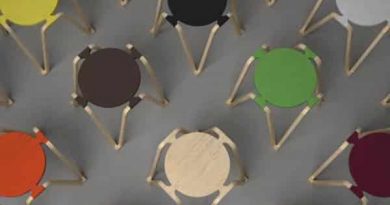Open Innovation: Comprehensive Guide and Examples
Innovation and creativity are essential factors to achieve competitive advantages in the market. Innovative companies adopt strategies that aim to improve both the input and output sides of the innovation equation by reducing the input costs or increasing the production volume. All types of innovation, including both open innovation and closed innovation, can be applied on four primary levels inside the company: business model innovation, product & service innovation, process innovation, and technology innovation. However, the innovation process is faced with obstacles on those four levels. For example, the product development process faces hindrances such as a short product lifecycle, high innovation costs and increasing product complexity through a different release. The R&D team inside the company should overcome these obstacles.
What is Open Innovation?
Many companies recognise open innovation as overcoming obstacles during the design process. Chesbrough (2003a, p.XXIV) defined open innovation as a paradigm that assumes that firms can and should use external ideas as well as internal ideas and internal and external paths to market as firms look to advance their technology.” Figure 2 represents the diagram of an open innovation model. At the same time, the innovation process is divided into two main stages: research and development. The research phase includes inputs from outside the boundaries of the company. Many companies provide a successful example of one innovation model to solve problems, such as IBM (IBM Design Thinking Model: A Shift Toward Big Enterprises), which patterned with other companies to develop semiconductor technologies. Apple and P&G implemented open innovation to create new products. Other companies used the open innovation model to build new business models, such as Facebook, Salesforce.com, IBM, and Linux.
Note: A PDF copy of this report can be downloaded here.
What is open innovation? And Why is it important?
The Closed versus Open Innovation model
In the traditional closed innovation model, the R&D process depends on internal laboratories and resources, while new ideas and technologies are investigated and presented by internal resources. The closed innovation model in Figure 1 represents the flow of creative ideas inside the R&D process. The dashed line represents the company’s boundaries, where all the creative ideas are produced inside the company body. Creative ideas flow to the research stage, where selected ideas are filtered and selected during the research process. Selected ideas are moved to the next development stage. Winning ideas are presented to the market through new innovative products or services.
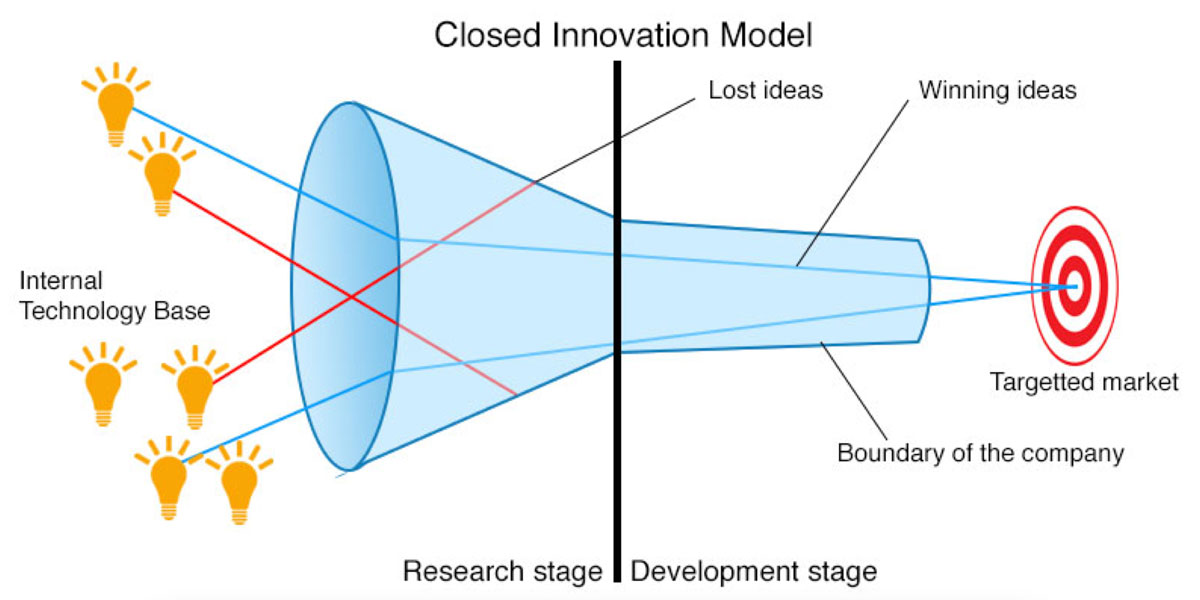
On the other side, the open innovation model aims to combine both internal and external use of innovation and technologies to provide a larger or possibly more efficient flow of ideas to the research stage compared with the close innovation model. Figure 1 presents the open innovation model and shows that creative ideas are drawn from inside and outside the company’s boundaries (Simic, 2013). The closed and open innovation models indicate a strong correlation between research and development. Open innovation is also introduced to combine short-term financial interest and long-term innovation requirements inside the firm. The profit gained from external knowledge can reduce the internal investment in the long-term research process (The Double Diamond Design Thinking Process and How to Use it).
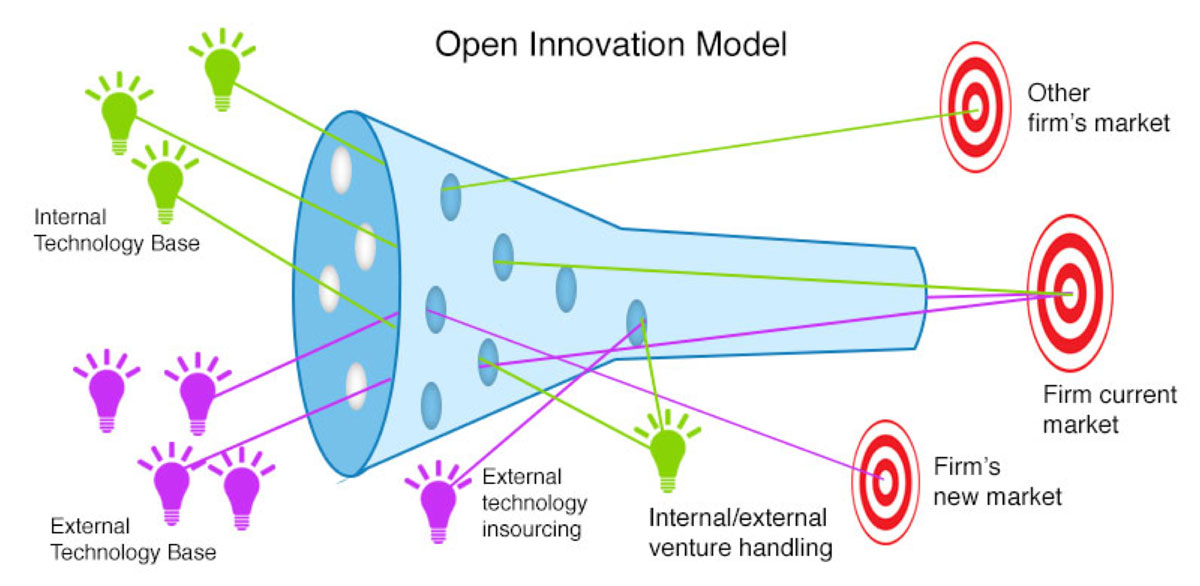
Benefits of the Open Innovation Model
Henry Chesbrough developed the open innovation model to enable companies to combine internal and external ideas from external parties or partners to achieve product innovation and consumer satisfaction. In contrast to the closed innovation model, six characteristics can be identified:
- While the closed innovation model assumes that the resources and employees who can reach innovative ideas are located inside the organisation, open innovation indicates that innovative ideas are not locked inside the company’s boundaries. The ideas can be driven from outside sources in addition to internal sources.
- The closed innovation model assumes that in achieving the targeted profit from innovation, internal employees should discover and manage the ideas. However, the open innovation model values external ideas and is open to the values that can lead to the target’s profit and market advantages.
- While the traditional innovation model is based on the expertise that internal resources should discover and manage to achieve the market lead, open innovation aims to merge external innovative ideas and internal management.
- While the closed innovation model depends on priority in leading the market with new ideas, open innovation indicates that a company should be involved in basic research to benefit from it.
- The closed innovation model assumes that internal resources are needed to produce the most innovative ideas to lead the market. On the other hand, open innovation depends on utilising internal and external ideas and merging them.
- The closed innovation model aims to limit the innovation profit to the company by having full control over the innovation process. On the other hand, open innovation aims to utilise all available resources that can lead to an efficient process.
The open innovation model provides a non-traditional model for a company to utilise creativity from internal and external resources. This model drives researchers to believe that this model can lead to more creativity inside organisations. However, the open innovation model faces several challenges that could inhibit creativity inside the organisation as a reversed impact of these challenges. Therefore, a clear understanding of the company’s boundaries and identity must be considered to evaluate the creative potential inside the organisation’s strategic thinking.
Creativity Levels in Open Innovation
While many companies adopt innovative strategies to compete in the market, few can succeed, especially in startups. Companies with fewer resources were able to achieve success compared with others with a higher resource profile. Many concepts and types of innovation have been introduced and resulted in a broader understanding of the innovation concept (Strazdas & Cernevicuite, 2015). The R&D team should have a clear vision of the innovation strategy inside the company to improve the design process to achieve the business target. In the early development process, the R&D team faces several questions about “what should be innovated?” and “how to innovate it?”. Answers to similar questions can be provided by understanding the different creativity levels inside the open innovation model that can be classified into inbound, outbound, and coupled perspectives, as shown in Figure 3.
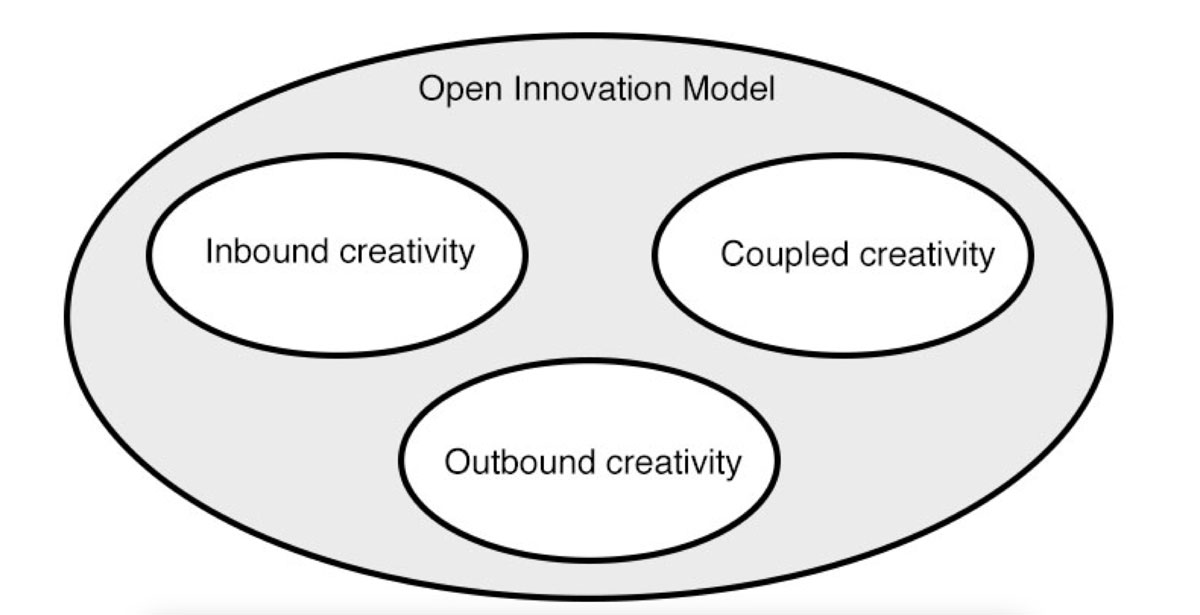
Inbound creativity
When the company does not know what to innovate, inbound creativity can inspire the internal R&D department with answers based on researching external resources such as customer feedback and needs. This external knowledge is used to guide the innovation process inside the organisation to develop innovative products and services that meet end consumer expectations. Deutsche Telekom, for example, uses insights collected about the consumer in their environment to develop innovation inside the company. Procter & Gamble developed innovation models such as (connect and develop), and every year, the company identify the top ten of its consumer requirements and needs. The R&D department used this collected information in the research and innovation process. Inbound creativity improves innovation inside the firm by monitoring the operating environment and collecting information from its partners.
Outbound creativity
Many innovative products or technologies developed by the R&D departments fail to succeed. or fit into the existing business model of the company. The failed products are replaced with new ones and considered a loss in the innovation budget. Chersbrough (2010) indicated that projects that fail inside the company’s business model could find their way to success outside the company by marketing them through an innovative business model differently than the currently implemented model inside the company of origin. For example, the Ethernet network protocol developed at Palo Alto Research Center from Xerox is an example. To reduce the costs, Xerox leased the technology to a former employee, whose spin-off was named 3Com. Although the initial technology usage was limited to serve the company’s business scope, the spin-off achieved more success based on the new marketing strategy.
Coupled creativity
Coupled creativity works similarly to the inbound creativity model. The difference is that coupled creativity aims to build a partnership to collect information from the operating environment. This partnership can be either formal or informal. One of the examples of applying this model is the (Ecomagination Challenge) presented by General Electric in 2010. The community of organisations, research institutes, universities, NGOs and individuals were invited to present their ideas to create smart and efficient grid technologies. A committee evaluated ideas, and the winner received a prize, investments or commercial relationship. The example provided by GE indicates that the company used external knowledge in building an innovative product that met the market needs.
Tom Hulme, Founder and Managing Director of OpenIDEO, speaks about innovation collaboration at London Business School’s Global Leadership Summit about open innovation and collaboration.
The closed innovation model limits the ability to reach new innovative ideas (What is the 8D Problem Solving? And How to use the 8D Report?) as it only depends on the company’s resources (Panduwawala et al., 2009). In contrast, open innovation maximises the opportunity to develop innovative ideas by expanding the company’s creative capability through internal and external resources and knowledge (Simic, 2013). As a result, the open innovation model leads to a better creative environment and maximises the chances to reach innovative products that can succeed in the market.
Applying Open Innovation in Different Business Models
Both innovation and business models applied within the company are connected. While the R&D department contributes to the research and innovation related to product development, the business model completes the production process to deliver the final product or service. Business models are classified as either open or closed business models. The open innovation and open business models are closely related and presented by Chesbrough (2007). However, there is no clear definition of the “open business model”. Scholars have tried to provide a solid definition for the term, such as Teece (2010, p. 191), who defined the open business model as: “A business model describes the design or architecture of the value creation, delivery and capture mechanisms employed by a particular business.” Chesbrough and Vanhaverbeke (2014) highlighted the relationship between the open business model and the value of creating, capturing, and delivering new products and services to the market. In contrast, in the closed business model, firms depend on their assets and chain partners through marketing transactions (Chesbrough & Vanhaverbeke, 2014).
Innovation links to closed and open business models based on the creativity level described earlier in the Innovation section of this report: inbound creativity and outbound creativity. Coupled creativity can be considered a type of inbound creativity.
Inbound open innovation
Using inbound innovation to combine external knowledge with the closed business model is commonly applied by different companies. P&G is one of the companies with successful innovative ideas created by external partners and brought to market by P&G, such as Swiffer Dusters, TidePods, and Olay Regenerist. In open business models, inbound innovation can be turned into a new business model. Apple iPhone provides an example of a product mainly developed in-house and released in June 2007. Opening the device to third-party applications in March 2008 enabled developers to use the Apple Store to sell their mobile applications, turning the product into a new developing platform and adding more value to the product with each provided application.

Outbound open innovation
In the closed business model, unused knowledge is transferred to others. This model is used in most licensing agreements and spin-offs. The technology is transferred from the original manufacturers to the recipient, who completes the production process and introduces it to the market. The original innovator is not involved in the product development after the technology is transferred to the new company. Outbound open innovation can also be combined with open business models to make internal knowledge accessible to others to develop new business models. For example, IBM has supported Linux OS with patents and invested $100 million a year to support its competition with the Microsoft operating system (How Inclusive Design Reshaped Microsoft Products).

Combining the different open innovation types with both closed and open business models can maximise the potential of the innovation and creativity process. Innovation cost becomes less risky as the innovative product or technology can be implemented in different channels based on the business model and how open innovation is used in the R&D process. For example, the Apple iPhone gained more value in the market by turning from an innovative product to a platform for developing third-party applications. On the other hand, investing in a partner’s innovation process, similar to the IBM investment in Linux OS development, improves the competitive position in the market against existing strong competitors such as Microsoft.
Case Study: Lego
LEGO is one of the leading companies in the toy-making industry that led the market through innovation and creativity. The company was founded in 1932 by Danish carpenter Ole Kirk Christiansen in the Danish village of Billund. The company started by manufacturing furniture and small objects such as stepladders, ironing boards, and wood toys. The word “LEGO” is constructed from the Danish word “leg godt”, which means “play well”. Also, “LEGO” means “I put together” in Latin. The current innovation model in LEGO was established in 2004 as the company started a seven-year strategy called the Shared Vision. This strategy aims to rebuild the company’s brand identity as a creative toy manufacturing enterprise. Part of the strategy in LEGO is to ensure that a business plan supports the innovation process and design activities. To achieve this goal, a business model was applied known as the LEGO Design for Business (D4B) model (Council, 2007). The D4B plan is based on designing innovative related tools and actions such as:
- Facilitating LEGO-wide discussions about innovation,
- Creating a foundation document to build communication between the creative lead, marketing lead, and project leader,
- Hold challenge sessions to sharpen the core team objectives, and
- Create a roadmap document to align objectives, tasks, and deliveries.
The LEGO innovation model aims to help the company achieve three main targets: participate in discussions during the early stage of production, understand the knowledge and resources required to succeed, and assess the results against the company objectives in different project stages. Based on these goals, LEGO’s approach was that instead of changing their current process and product, the company needed to apply minor changes and optimisation of the known issues in the products and process, reconfigure the existing parameters to meet the consumer needs and redefine new approaches to the product’s level while modifying the existing process and products.
The Innovation in Lego
The open innovation strategy has been implemented in LEGO on both the process and production levels. Erik Hansen, LEGO’s Senior Director of Open Innovation, adopted open innovation and crowdsourcing strategies to achieve company success. Erik’s plan is based on assessing the existing opportunities, needs, and benefits for implementing open innovation in the company. LEGO’s open innovation strategy focused on three main elements:
- Learning from external companies through interviewing twelve of the leading open innovation firms.
- Learning from internal practitioners through feedback and interview methods.
- Building micro pilots to test the company’s capabilities, consumer culture, and needs.
The innovation process is organised in LEGO by splitting it into eight types: product development and business model innovation. The responsibility for the innovation process is shared between four function groups: the Concept Lab, the Product and Marketing Development, and the Communication, Education and Direct Unit.
In addition to the process level, LEGO implemented the open innovation model to improve its products through new and fresh ideas from external resources. These resources can be linked to their existing clients or other companies with experience in open innovation. In 2008, LEGO launched LEGO Ideas, a platform open for anyone to submit innovative ideas. LEGO received proposals from 10,000 users. These ideas have been reviewed, and the winning idea is moved to the production process. The original owner of the idea receives 1% of the selling royalties. LEGO Ideas was the reason for innovating new sets such as Big Bang Theory, Ghostbusters, and Back to the Future (Wilkins, 2015). LEGO IDEAS can be accessed through the domain name https://ideas.lego.com.
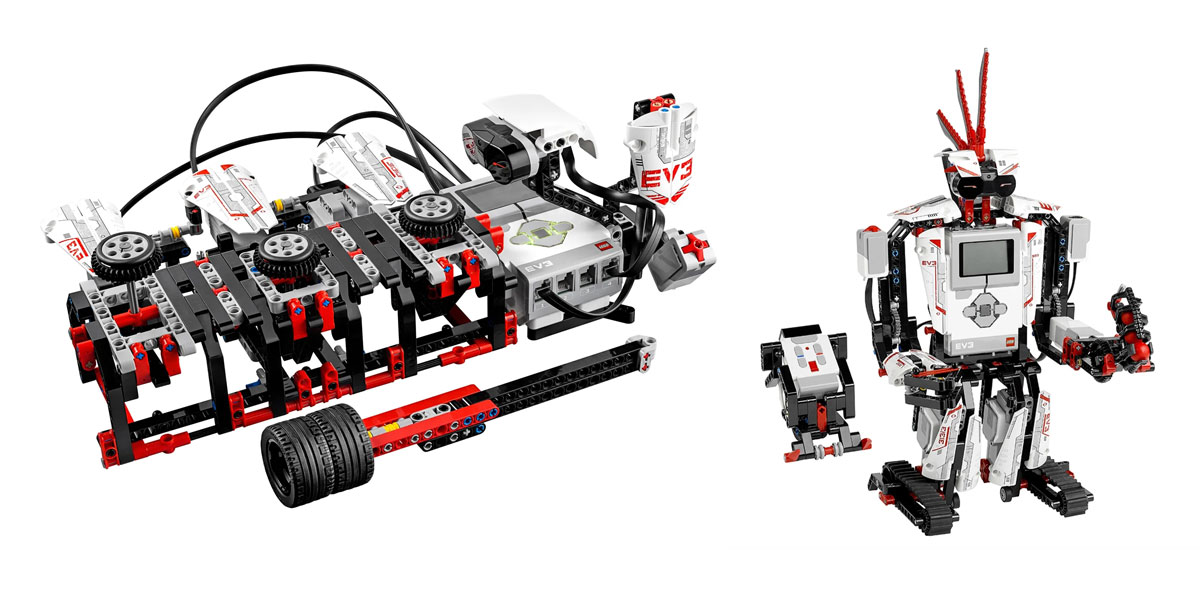
Co-creation is another tool for an inbound open innovation model to innovative products through collaboration with external organisations. LEGO’s executive team built a partnership between the company and MIT Media Lab to deliver programmable bricks, which was introduced as LEGO Windstorm. The new product was initially introduced as an education method to teach children robotics as they can build LEGO models that could move. Its software was closed in an early product version and could only be edited by unauthorised modifications to do more functions. Later, LEGO opened the software to expand the innovation space among consumers. Another innovation dimension can be observed in LEGO’s partnership with MIT Media Lab, which is turning from closed to open software. Someone was able to hack through the LEGO software that comes with the motors to apply more functions. While this was considered illegible by many, LEGO opened the software in a way anyone can modify to observe what the end consumers can create. This open innovation approach has a positive impact on the company and the curriculum developed in the United States to teach students robotics. Although the product was initially introduced as an educational tool, it gained popularity and acceptance among both adults and children.
LEGO provides a practical example of applying two levels of the open innovation model: inbound innovation through listening to ideas from external consumers and companies and coupled innovation through its partnership with external organisations such as the MIT Media Labs. Both the inbound and coupled open innovation models helped the company to improve the internal process and reach a solid linkage between creative and business targets inside the company on the one hand, and present new products to the market that was not their original intention, such as the programmable bricks on the other.
Conclusion
Both closed, and open innovation models have been implemented into company business models to achieve competitive advantages in the market. While the closed innovation model depends on internal resources and assets to reach new ideas and technologies, the open innovation model extends the ability to create and innovate through the use of external resources and the partnership capability of the company.
The open innovation model can be applied on different levels: the inbound creativity level, the outbound creativity level, and the coupled creativity level. The inbound creativity model identifies that the R&D department can inspire ideas and technologies from external resources to reach answers for early innovation stage questions such as “What should be innovated?” and “How to innovate it?”. Outbound creativity assumes that products that fail inside the company can find their way to success outside through marketing using a different business model. Coupled creativity is similar to the inbound model. The difference is that coupled creativity aims to build partnerships with other companies in order to achieve market advantages.
The article finds that while both closed and open innovation models aim to improve a company’s innovation process, the open innovation model extends the company’s ability to innovate through the usage of external resources and assets in the R&D process. On the other hand, the closed innovation model limited the company’s ability to reach more creative ideas and subsequently lowered its ability to compete in the market.
The open innovation model is closely connected with the company’s business model. Inbound creativity is used within the closed business model to research new product ideas. In the open business models, open innovation can be used to create new business models. On the other hand, outbound creativity works with the closed business model to transfer the knowledge to other companies, while it combines with the open business model to make the internal knowledge accessible to others.
The report finds that the open innovation model can be combined with both closed and open business models in order to reach a wide range of output. The different results of combining inbound creativity and outbound creativity on the one hand and the closed and open business models on the other can fuel the innovation process with more ideas and applications that work within and outside the company.
LEGO was presented as a case example to investigate the practical implementation of the open innovation model. This report finds that LEGO was able to implicate open innovation successfully. However, LEGO applied both inbound and coupled creativity with no evidence to apply outbound creativity. LEGO Ideas presents an example of inbound creativity by driving consumers to suggest new ideas. This type of innovation results in new products such as Big Bang Theory, Ghostbusters, and Back to the Future. LEGO’s co-creation is an example of coupled creativity through its partnership with MIT Media Labs (Strazdas & Cernevicuite, 2015). This type of innovation resulted in the release of LEGO programmable bricks.
This report concludes that implementing an open innovation model can drive innovation and creativity within the organisation on both the process and production levels. Each type of creativity level inside the open innovation model has different characteristics and outputs when combined with the different business models.
Bibliography
Bucic, T. and Ngo, V. (2012) Examining drivers of collaborative inbound open innovation: Empirical evidence from Australian firms. International Journal of Innovation Management, 16(04).
Bughin, R., Chui, M. and Johnson, B. (2008) The Next Step in Open Innovation. The McKinsey Quarterly, 4, pp. 113.
Chesbrough, H. (2007) Why Companies Should Have Open Business Models. MIT Sloan Management Review, 48(2), 22–28.
Chesbrough, H. (2010) Business model innovation: opportunities and barriers. Long-range planning, 43(2), 354-363.
Chesbrough, H. (2011). Bringing open innovation to services. MIT Sloan Management Review, 52(2), 85-90.
Chesbrough, H. (2012) GE’s ecomagination challenge: An experiment in open innovation, California Management Review. 54 (2012), 140–154.
Chesbrough, H. W. (2003). Open innovation: The new imperative for creating and profiting from technology. Boston: Harvard Business Press.
Chesbrough, H., Vanhaverbeke, W., and West, J. (2006) Open Innovation: Researching a New Paradigm. Oxford, GBR: Oxford University Press, UK. Council, D. (2007) Eleven lessons: managing design in eleven global companies. London: Design Council.
Design Management Europe Award. (2009) DME Award Poster: LEGO. [Online] Available from: http://www.dmeaward.com/wp-content/uploads/2013/07/LEGO.pdf. [Accessed: 6th May 2015]
Henkel, J. (2006) Selective revealing in open innovation processes: The case of embedded Linux. Research Policy, 35(7), 953-969.
Huston, L. and Sakkab, N. (2006) Connect and Develop: Inside Procter & Gamble’s new model for innovation, Harvard Business Review 84 (2006), 58–66.
Lauwaert, M. (2008) Playing outside the box–on LEGO toys and the changing world of construction play. History and Technology, 24(3), 221-237.
Lindegaard, S. (2014) 3 Successful Open Innovation Cases: GE, Samsung and LEGO. [Online] Available from: https://www.linkedin.com/pulse/20141115202453-46249-3-successful-open-innovation-cases-ge-samsung-and-lego?trkInfo=VSRPsearchId%3A43274941430657186999%2CVSRPtargetId%3A5939482912805122048%2CVSRPcmpt%3Aprimary&trk=vsrp_influencer_content_res_name. [Accessed: 6th May 2015]
Marques, P. (2014) Closed versus Open Innovation: Evolution or Combination? International Journal of Business and Management, 9(3), p196.
Nerone, M., Osiris J., and Liao, Y. (2014) Classification of the Open Innovation Practices: the Creativity Level. Brazil: IOS Press.
Oberoi, P., Haon, C., & Bodas Freitas, M. (2014) Organising for Open Innovation: Incorporating the Externality of Control with Diversity of Contribution. Management, 17(3), 180-192.
Osterwalder, A. (2007) Competitive Advantage through Business Model Design and Innovation. [Online] Available from: http://www.slideshare.net/innovationexcellence/competitive-advantage-through-business-model-design-and-innovation?qid=0f76148c-cb69-4cef-a189-456d461e0144&v=default&b=&from_search=2. [Accessed: 6th May 2015]
Panduwawala, L., Venkatesh, S. Parraguez, P. & Zhang, X. (2009) Connect and Develop, p&g’s big stake in one innovation, Msc in innovation and technology management,. University of Bath.
Robertson, D. and Hjuler, P. (2009) Innovating a Turnaround at LEGO. Harvard Business Review, 87 (9), pp. 20-21.
Rohrbeck, R., Hoelzle, K. and Gemünden H. (2009) Opening up for competitive advantage – How Deutsche Telekom creates an open innovation ecosystem, R&D Management 39 (2009), 420–430.
Simic, D. (2013) Applied Open Innovation – A Case Study Analysis based on Electric Drive Technology Projects in the Automotive Industry. Vienna: Austrian Institue of Technology
Strazdas, R., & Cerneviciute, J. (2015) System Innovation Approach for Improvement of Innovation Development in Creative Industries. Researchgate.
Teece, J. (2010) Business Models, Business Strategy and Innovation. Long Range Planning, 43(2–3), 172–194.
Wang, Z. et al. (2009) Competition, Innovation And Productivity Growth. [Online] Available from: http://www.slideshare.net/zhanwang/competion-innovation-and-productivity-growth?qid=73f69ef7-3bd0-4479-9166-4d4b18be1d47&v=default&b=&from_search=14. [Accessed: 6th May 2015]
Weiblen, T. (2014) The Open Business Model: Understanding an Emerging Concept. Journal of Multi Business Model Innovation and Technology, 1, 35-66.
Westergren, H. (2010). Open Innovation Success or Failure-The Impact of Contextual Factors. In System Sciences (HICSS), 2010 43rd Hawaii International Conference (2010) pp. 1-10.
Wilkins, E. (2015) Open Innovation: Lego & Bagels. [Online] Available from: https://www.linkedin.com/pulse/open-innovation-lego-bagels-elliott-wilkins?trkInfo=VSRPsearchId%3A43274941430657186999%2CVSRPtargetId%3A5973124321869066240%2CVSRPcmpt%3Aprimary&trk=vsrp_influencer_content_res_name. [Accessed: 6th May 2015]
Wit, J., Dankbaar, B. and Vissers, G. (2007) Open innovation: the new way of knowledge transfer?. Journal of Business Chemistry, 4(1), 11-19.
Wolf, J. (2014). LEGO Studies. New York: Taylor & Francis.
Note: A PDF copy of this report can be downloaded here.
Article Citation: Elmansy, R. (2015) Report: Implementing Open Innovation to Drive Creativity Inside Companies. [Online] Available from: https://www.designorate.com/open-innovation-to-drive-creativity. [Accessed: October 2015]
Open innovation is a paradigm that assumes that firms can and should use external ideas as well as internal ideas, and internal and external paths to market, as firms look to advance their technology.
LEGO’s partnership with MIT Media Lab is a good example of open innovation, which is turning from closed to open software. Someone was able to hack through the LEGO software that comes with the motors in order to apply more functions. While this was considered illegible by many, LEGO opened the software in a way that anyone can modify to observe what the end consumers can create. This open innovation approach has a positive impact not only on the company but also on the curriculum developed in the United States to teach student robotics. Although the product was initially introduced as an educational tool, it gained popularity and acceptance between both adults and children.
Inbound Open Innovation: When the company does not know what to innovate, inbound creativity can inspire the R&D department with answers based on researching external resources such as customer feedback and needs.
Outbound open innovation: Many innovative products or technologies developed by the R&D departments fail to achieve success in the market or fit into the existing business model of the company. The projects that fail inside the company’s business model could find their way to success outside the company by marketing them through an innovative business model.
Article cover image copyrights: Image by macrovector on Freepik.




